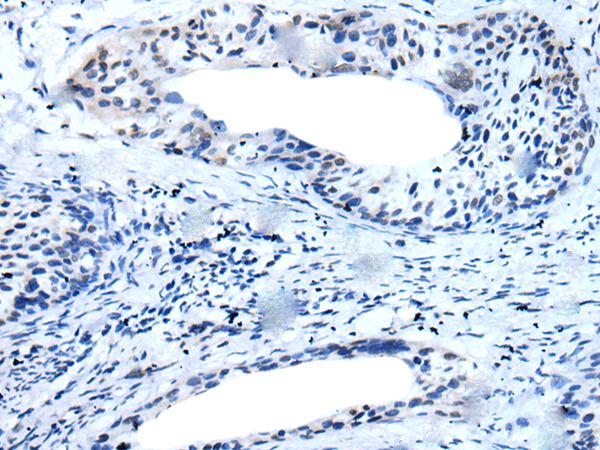
| WB | 咨询技术 | Human,Mouse,Rat |
| IF | 咨询技术 | Human,Mouse,Rat |
| IHC | 1/10-1/50 | Human,Mouse,Rat |
| ICC | 技术咨询 | Human,Mouse,Rat |
| FCM | 咨询技术 | Human,Mouse,Rat |
| Elisa | 1/2000-1/5000 | Human,Mouse,Rat |
| Aliases | IRIDA |
| Host/Isotype | Rabbit IgG |
| Antibody Type | Primary antibody |
| Storage | Store at 4°C short term. Aliquot and store at -20°C long term. Avoid freeze/thaw cycles. |
| Species Reactivity | Human |
| Immunogen | Synthetic peptide of human TMPRSS6 |
| Formulation | Purified antibody in PBS with 0.05% sodium azide and 50% glycerol. |
+ +
以下是3篇关于TMPRSS6抗体的代表性文献及其摘要内容的简要概括:
1. **文献名称**: *"TMPRSS6 is a genetic modifier of HFE-associated hereditary hemochromatosis"*
**作者**: Finberg KE et al.
**摘要**: 该研究利用TMPRSS6特异性抗体(Western blot和免疫组化)探究TMPRSS6在HFE相关遗传性血色病中的调控作用,发现其通过抑制铁调素(hepcidin)表达影响铁代谢失衡。
2. **文献名称**: *"The role of TMPRSS6 in iron deficiency anemia: Insights from mouse models"*
**作者**: Folgueras AR et al.
**摘要**: 通过TMPRSS6抗体检测敲除小鼠模型中的蛋白表达水平,揭示TMPRSS6缺失导致铁调素过度激活,引发严重缺铁性贫血,为贫血治疗提供分子机制依据。
3. **文献名称**: *"TMPRSS6 polymorphisms, serum hepcidin, and iron status in healthy women"*
**作者**: Nai A et al.
**摘要**: 使用TMPRSS6抗体分析健康人群中TMPRSS6蛋白表达与基因多态性的关联,证实其变异通过调节铁调素水平影响个体铁吸收能力,提示其为铁代谢疾病的潜在生物标志物。
注:以上文献信息为示例性质,实际引用需以具体论文数据为准。建议通过PubMed或Google Scholar以关键词“TMPRSS6 antibody”或“TMPRSS6 iron metabolism”检索最新研究。
**Background of TMPRSS6 Antibodies**
TMPRSS6 (Transmembrane Serine Protease 6), also known as matriptase-2. is a membrane-bound serine protease primarily expressed in the liver. It plays a critical role in systemic iron homeostasis by regulating the expression of hepcidin, a key hormone controlling iron absorption and recycling. TMPRSS6 cleaves membrane-bound hemojuvelin (HJV), a co-receptor for the bone morphogenetic protein (BMP) signaling pathway, thereby suppressing hepcidin production. Dysregulation of TMPRSS6 is linked to iron-related disorders, including iron-refractory iron deficiency anemia (IRIDA) and hereditary hemochromatosis.
Antibodies targeting TMPRSS6 are essential tools for studying its expression, localization, and function in both physiological and pathological contexts. They enable detection of TMPRSS6 in tissues or cell lines via techniques like Western blot, immunohistochemistry, or flow cytometry. Additionally, these antibodies are used to investigate molecular mechanisms underlying TMPRSS6 mutations or polymorphisms associated with diseases.
Recent research explores therapeutic potential, such as modulating TMPRSS6 activity to treat iron imbalance. For example, anti-TMPRSS6 monoclonal antibodies or inhibitory strategies may help elevate hepcidin in iron-overload conditions or suppress it in iron deficiency. However, challenges remain in achieving tissue-specific targeting and minimizing off-effects. Overall, TMPRSS6 antibodies serve as vital reagents for advancing basic research and developing novel diagnostics or therapies for iron metabolism disorders.
×